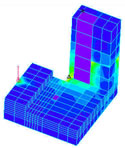7/22/2009· Accident Investigation & Reconstruction
Forensic Engineering Experts: Warnings
A warning must inform individuals of a danger, which would not be obvious to them. It must tell them how to avoid the danger, and be easily understood. It should also provide them with the consequences of not heading the warning.



 Structural failure can often produce catastrophic results. In many cases, the damage seen after the accident is not indicative of the cause of the initial failure. Fortunately, based on physical evidence, an investigator can frequently determine how and why a structure failed. The most common reasons for a failure include defective materials, defective design, improper assembly, excessive or improper loading or a combination of these. Through testing and structural analysis, it is possible to determine the root cause of the failure and propose solutions to prevent such failures from reoccurring.
Structural failure can often produce catastrophic results. In many cases, the damage seen after the accident is not indicative of the cause of the initial failure. Fortunately, based on physical evidence, an investigator can frequently determine how and why a structure failed. The most common reasons for a failure include defective materials, defective design, improper assembly, excessive or improper loading or a combination of these. Through testing and structural analysis, it is possible to determine the root cause of the failure and propose solutions to prevent such failures from reoccurring.






